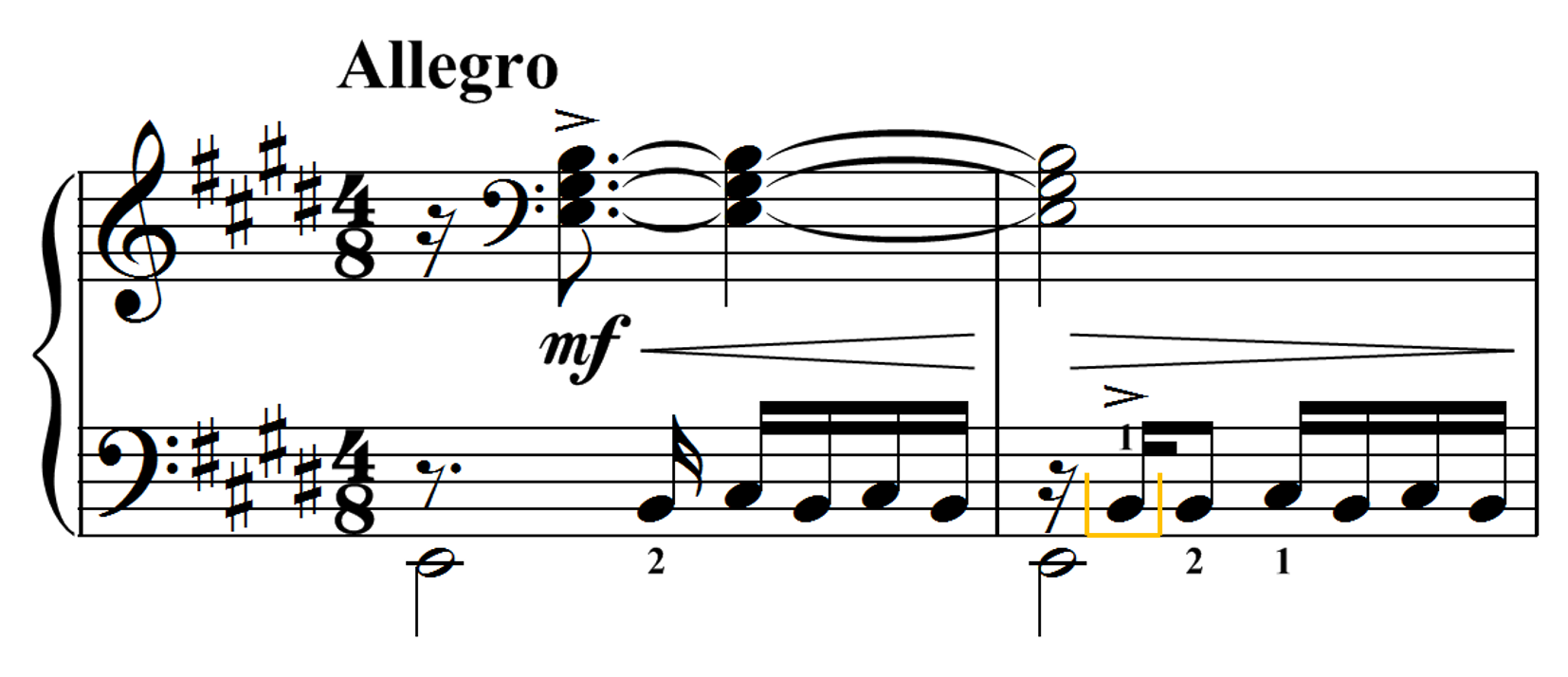“The accented B comes through more clearly when I play it with the right hand.”
Submitted by Michael Clark
Published on 10/4/2020

“The accented B comes through more clearly when I play it with the right hand.”
Submitted by Michael Clark
Published on 10/4/2020

“The accents in m. 51 come through more clearly when divided between the hands. I prefer to maintain the octaves in the right hand in m. 56 for consistency and less shifting in the left hand.”
Submitted by Michael Clark
Published on 10/4/2020

“If the C-sharp and E are played with right hand 1 2, the right hand has to move rather awkwardly to the next chord. Taking the C-sharp in the left hand enables less shifting in the right hand while still allowing enough time for the left to arrive in its next position.”
Submitted by Michael Clark
Published on 4/20/2020

“Taking the Bs in the left hand eliminates uncomfortable stretches in the right hand while allowing the melody to remain legato.”
Submitted by Michael Clark
Published on 10/4/2020

“The alto notes can be taken into the left hand in m. 12 without much trouble, freeing the right hand from awkward stretches.”
Submitted by Michael Clark
Published on 10/4/2020

“Taking the treble A in m. 21 with the left hand prevents an uncomfortable stretch in the right hand. I use long pedals in this passage, changing with the bass note.”
Submitted by Michael Clark
Published on 10/4/2020

“When I take the F-sharp with the right hand, I can play the chord without rolling it, which I find creates a more effective subito piano.”
Submitted by Michael Clark
Published on 10/4/2020

“Taking one additional note allows the right hand to remain in the same position going into m. 29.”
Submitted by Michael Clark
Published on 10/4/2020

“The left can take the D to alleviate the right hand stretch.”
Submitted by Michael Clark
Published on 10/4/2020

“This seems to be the distribution suggested by the rests and stem direction in m. 55. I play right-hand 2 and 3 in toward the fallboard with a tall wrist. I use the unusual scale fingering in m. 56 to allow the quarter note A to be held with 1.”
Submitted by Michael Clark
Published on 10/4/2020

“I find that the A fits more comfortably into my right hand. In the left hand it’s a little too stretched out when played with the inner notes.”
Submitted by Michael Clark
Published on 10/4/2020

“I find this division of the notes gives me the most control in the very soft dynamic.”
Submitted by Michael Clark
Published on 10/4/2020

“Taking these two notes with the left hand allows for a more graceful position shift in the right hand.”
Submitted by Michael Clark
Published on 10/4/2020

“In this case, a finger crossing can’t be avoided. I find it easier for the left hand to cross with finger 2 over the distance of a third than any alternate fingering in the right hand.”
Submitted by Michael Clark
Published on 10/4/2020

“Silently transferring the D-flat in m. 77 from the right hand to the left hand lets the chord sustain while allowing the right hand to position itself for what follows.”
Submitted by Michael Clark
Published on 10/4/20
Original:

Possible rhythm of grace note and rolled chord:

“In this fingering, the right-hand thumb takes the top F in the bass clef, allowing the left hand slightly more time to leap to the top note. This redistribution keeps the exciting choreography of the hand crossing while allowing for a more secure delivery.”
Read more about how I arrived at this fingering.
Submitted by Michael Clark
Published on 10/4/2020